Since its YTD high close of $308.53 on July 23, shares of the payment services platform PayPal (NASDAQ:PYPL) have fallen 24.6%, hitting a recent closing price of $232.59. The stock is now essentially flat for 2021, and the 12-month return is 24.96%.
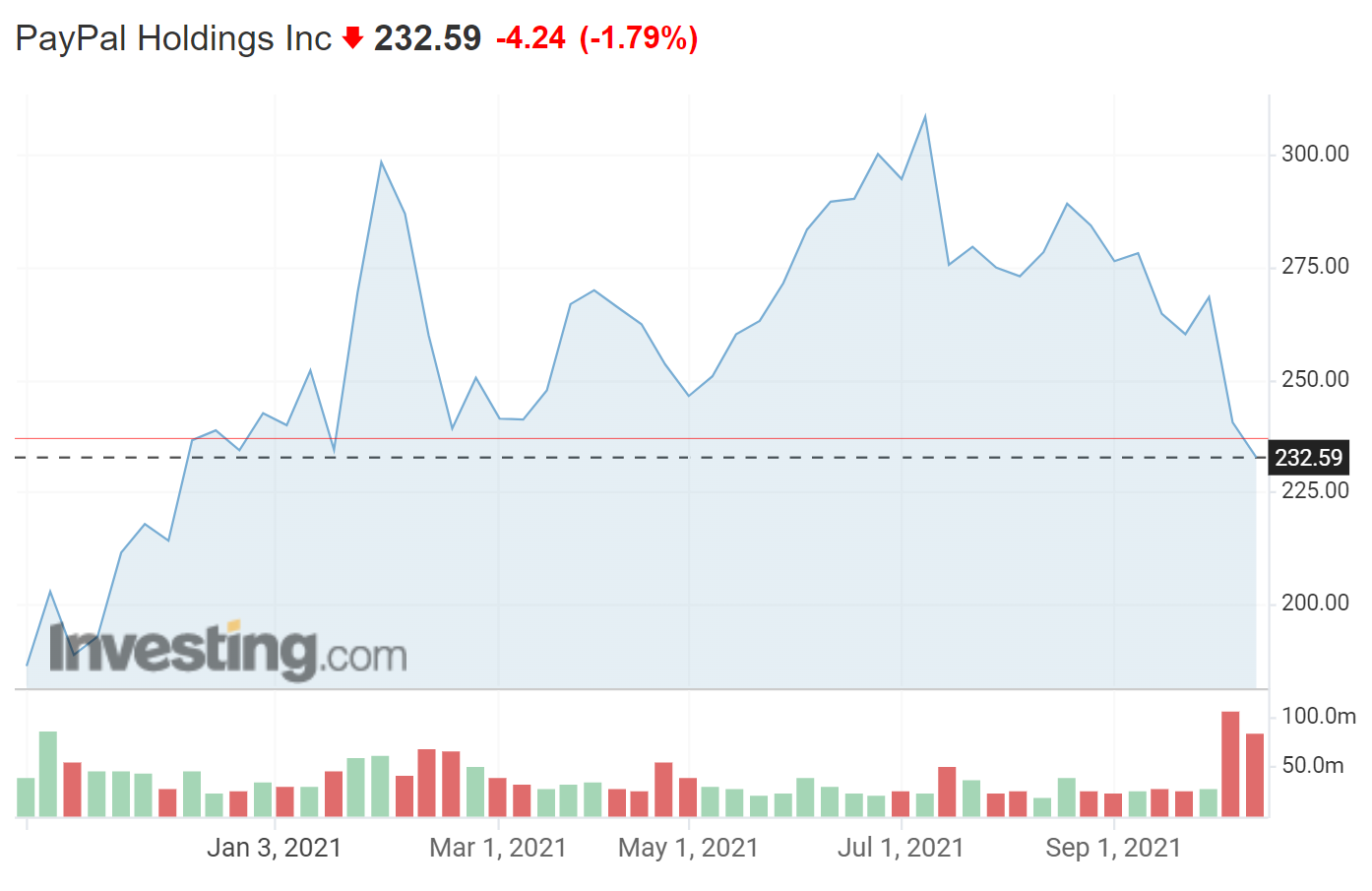
Source: Investing.com
Most of this year's decline happened since July 28 when PayPal reported Q2 earnings, even though EPS beat the consensus forecasts. Q2 earnings were lower than Q1, which was expected, but the market was apparently hoping for continued growth.

Source: ETrade. Green (red) values are amount by which EPS exceeded (missed) the consensus expected level.
So, as the digital payments platform approaches its Q3 earnings release on Nov. 8 it remains at a substantial discount to earlier in 2021. Recent rumors about PayPal potentially acquiring Pinterest (NYSE:PINS) were confusing to some investors—indeed, the shares rose 6% when the firm announced it was not currently planning to acquire the visual discovery engine.
I last wrote about PYPL on Mar. 11, 2021, and I assigned a neutral rating to the stock. While the company is a leader in digital payments, the bulls seemed to be discounting the competitive threats from a host of other major firms competing in this space (dubbed by some the big market delusion).
When I wrote the above article article, titled, "PayPall Bulls At Risk From 'Big Market Delusion,'" the consensus outlook from Wall Street analysts was bullish, with a 12-month price target that was 22.5% above the share price at that time. Since I published my analysis, PYPL has fallen 6.8%, as compared to the S&P 500’s price gain of 17.4% (not including dividends).
My analysis identified a significant red flag from the PYPL options market. The price of an option on a stock represents the market’s consensus estimate of the probability that the share price will rise above (call option) or fall below (put option) a specific level (the strike price) between now and when the option expires.
By analyzing the prices of call and put options at a range of strike prices, it is possible to calculate a probabilistic price return outlook for a stock that represents the overall consensus outlook from the options market. This is referred to as the market-implied outlook. For more information on this approach, including links to the relevant financial literature, see my overview post.
In March, the market-implied outlook for PYPL to early 2022 (calculated using options that expire on Jan. 21, 2022) was bearish. The peak probability outcome for this (roughly) 10-month period corresponded to a price return of -17.5%, with annualized volatility of 43%. In light of the substantial disagreement between the bullish Wall Street consensus and the bearish market-implied outlook, I compromised on a neutral rating.
Now as the Q3 earnings release looms, I have updated the market-implied outlook for PYPL for comparison with the Wall Street consensus outlook.
Wall Street Consensus Outlook for PYPL
E-Trade calculates the Wall Street consensus outlook for PYPL by combining the views of 16 ranked analysts who have published ratings and price targets within the past 90 days.
The consensus rating for PYPL is bullish (as it was in March) and the consensus 12-month price target is $333, 43.2% above the current price and about 10% above the 12-month price target in March.

Source: ETrade.com
Investing.com’s version of the Wall Street consensus outlook is based on rating and price targets from 46 analysts. The consensus rating is bullish and the consensus 12-month price target is 37.3% above the current price.
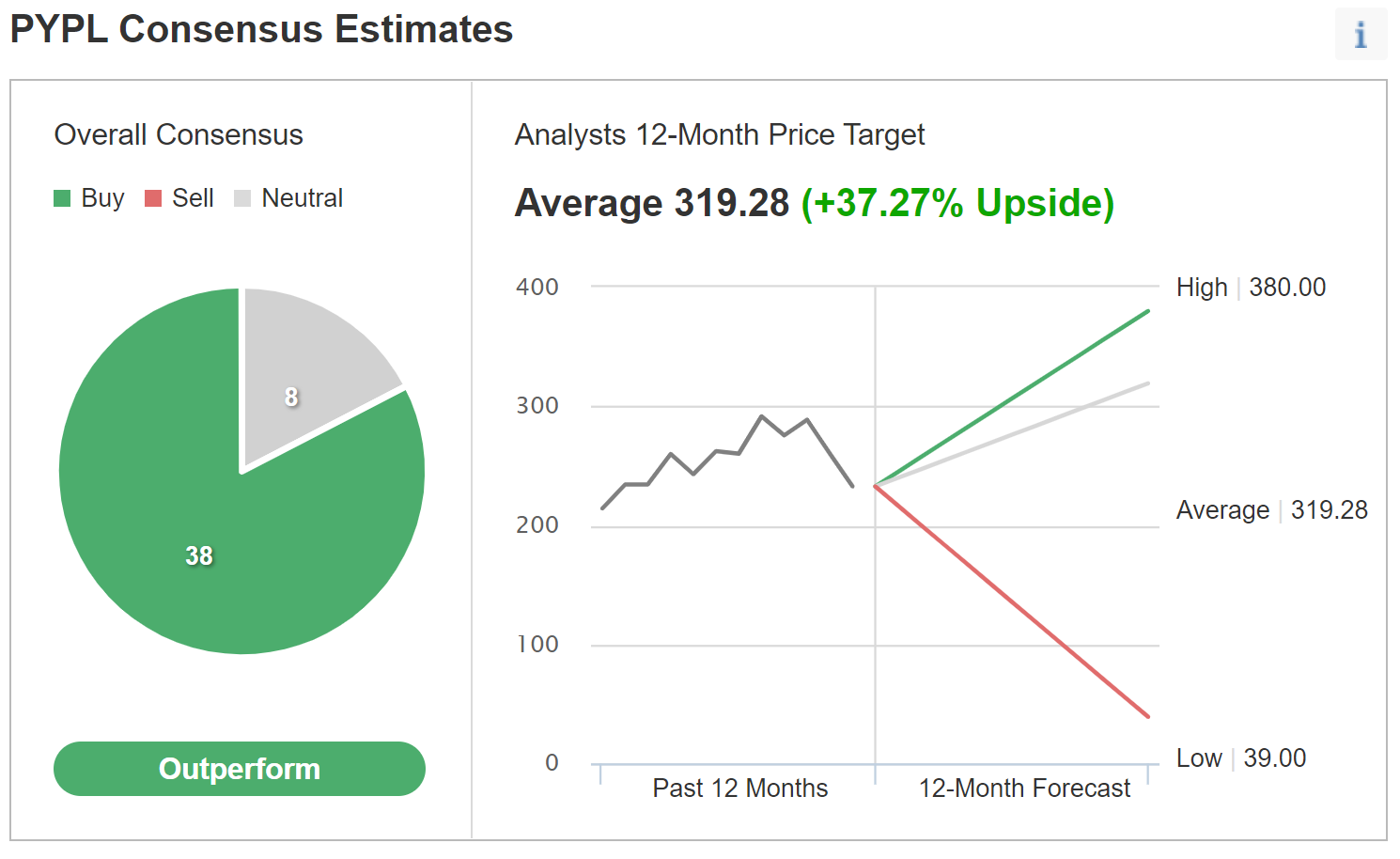
Source: Investing.com
Since my last analysis, the Wall Street consensus has been consistently bullish and the 12-month price target has risen as the share price has fallen. With the consensus 12-month price target at 40% above the current share price, investors who don't buy PYPL either need to believe that the outlook is far too optimistic or that the shares are so risky that even the high expected return is not compelling (or both).
Market-Implied Outlook for PYPL
I have analyzed call and put options at a range of strike prices, all expiring on Jan. 21, 2022, to generate the market-implied outlook for PYPL for the next 2.7 months (from now until that expiration date). I have also calculated the market-implied outlook for the 7.5-month period from now until June 17, 2022 using options that expire on that date.
The standard presentation of the market-implied outlook is in the form of a probability distribution of price return, with probability on the vertical axis and return on the horizontal.
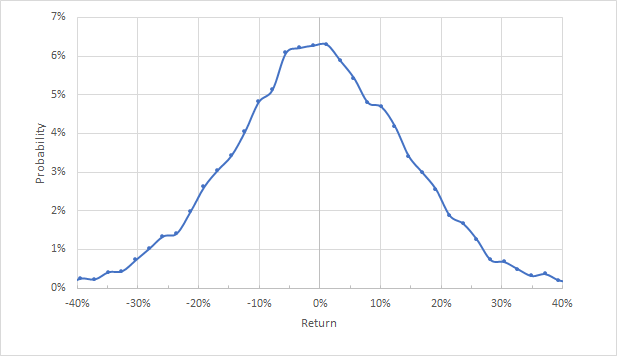
Source: Author’s calculations using options quotes from ETrade
The market-implied outlook for the next 2.7 months is generally symmetric, with comparable probabilities of positive and negative returns. The annualized volatility derived from this distribution is 37%. This expected volatility is a bit lower than the value I calculated in March (43%).
To make it easier to directly compare the relative probabilities of positive and negative returns, I rotate the negative return side of the distribution about the vertical axis (see chart below).
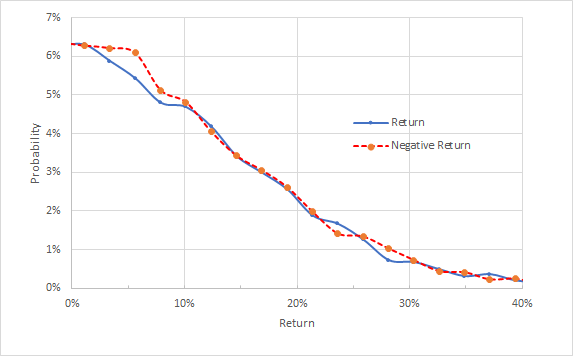
Source: Author’s calculations using options quotes from ETrade. The negative return side of the distribution has been rotated about the vertical axis.
This view of the market-implied outlook shows that the probabilities of positive and negative returns are almost identical for most outcomes (the solid blue line and the dashed red line are either very close or right on top of one another). The probabilities of negative price returns are slightly elevated for returns from -10% to 10% (0% to 10% on the chart above).
Theory suggests that the market-implied outlook tends to have slightly elevated probabilities of negative returns because investors, in aggregate, tend to be risk averse and pay more than fair value for put options. With this effect in mind, the market-implied outlook for the next 2.7 months looks slightly bullish.
The market-implied outlook for the 7.5-month period from now until June 17, 2022 looks somewhat bearish, with materially elevated probabilities of negative returns relative to positive returns for a wide range of the most-probable outcomes. The peak probability corresponds to a price return of -8.7% for the 7.5-month period. The annualized volatility calculated from this distribution is 35%.
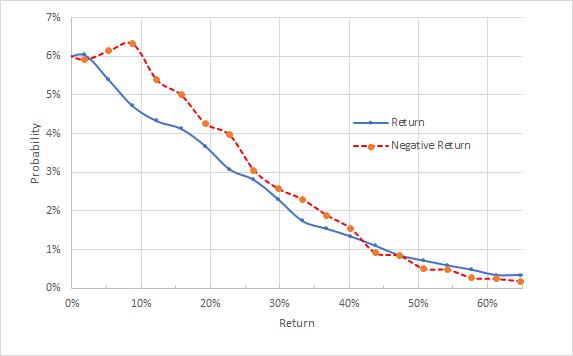
Source: Author’s calculations using options quotes from ETrade. The negative return side of the distribution has been rotated about the vertical axis.
The market-implied outlook for PYPL is slightly bullish to early 2022, shifting to moderately bearish to the middle of 2022. This suggests that the options market is somewhat optimistic about a near-term rebound in the shares, perhaps following a positive Q3 earnings surprise, but that the longer-term view is not great. The lower expected volatility, as compared to earlier this year, is a somewhat positive note.
Summary
PayPal is a company that I admire and the firm’s services are solid. In my experience, both PayPal and Venmo (which is owned by PayPal) work well and make digital payments very convenient. On the other hand, there are many other firms that provide similar functionality. I don’t experience any significant benefit for PayPal and Venmo vs. Zelle, for example.
The consensus view of the Wall Street analysts who follow PYPL is bullish, and suggests that the shares have massive upside potential. The Wall Street consensus 12-month price target is about 40% above the current share price. As a rule of thumb for a buy rating, I look for an expected 12-month return that is at least half the expected volatility (about 36% from the market-implied outlook).
Taking the Wall Street consensus outlook at face value, this would make PYPL look like a strong buy. The market-implied outlook to early 2022 is slightly bullish, shifting to moderately bearish by mid year. This is a substantial improvement relative to my last analysis.
Considering both the Wall Street consensus and the market-implied outlook, I am cautiously bullish on PYPL heading into earnings, but I have a neutral longer-term view.
